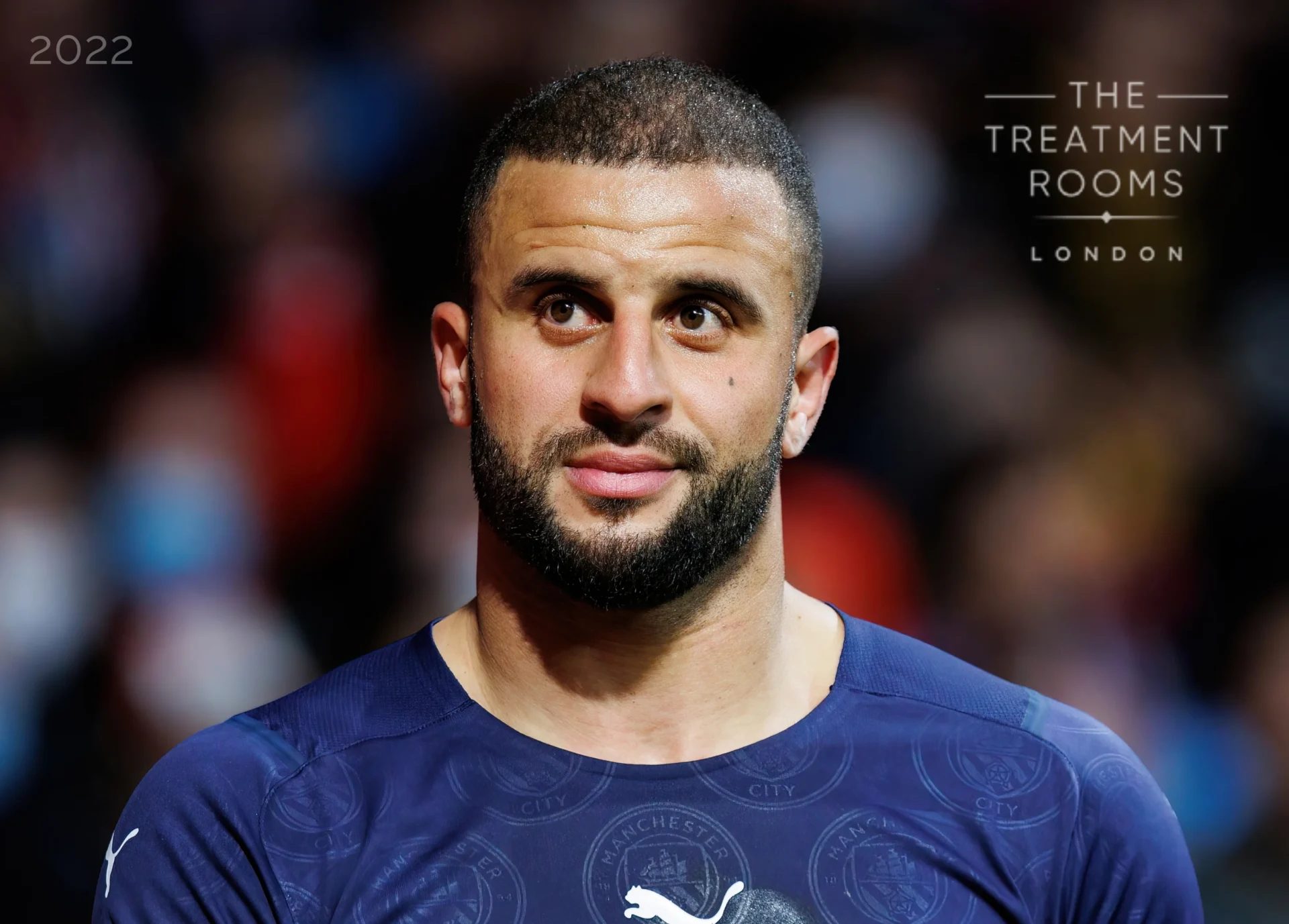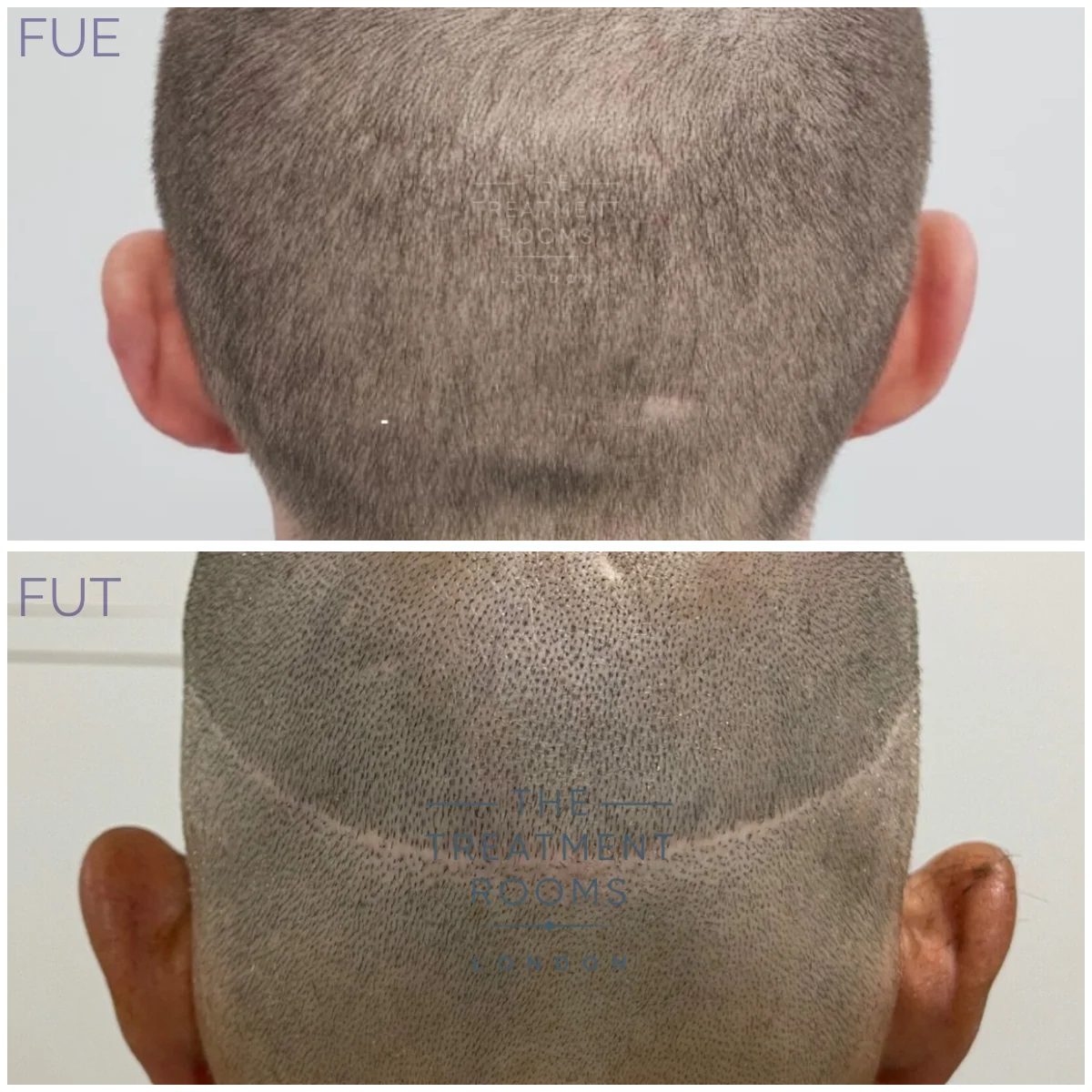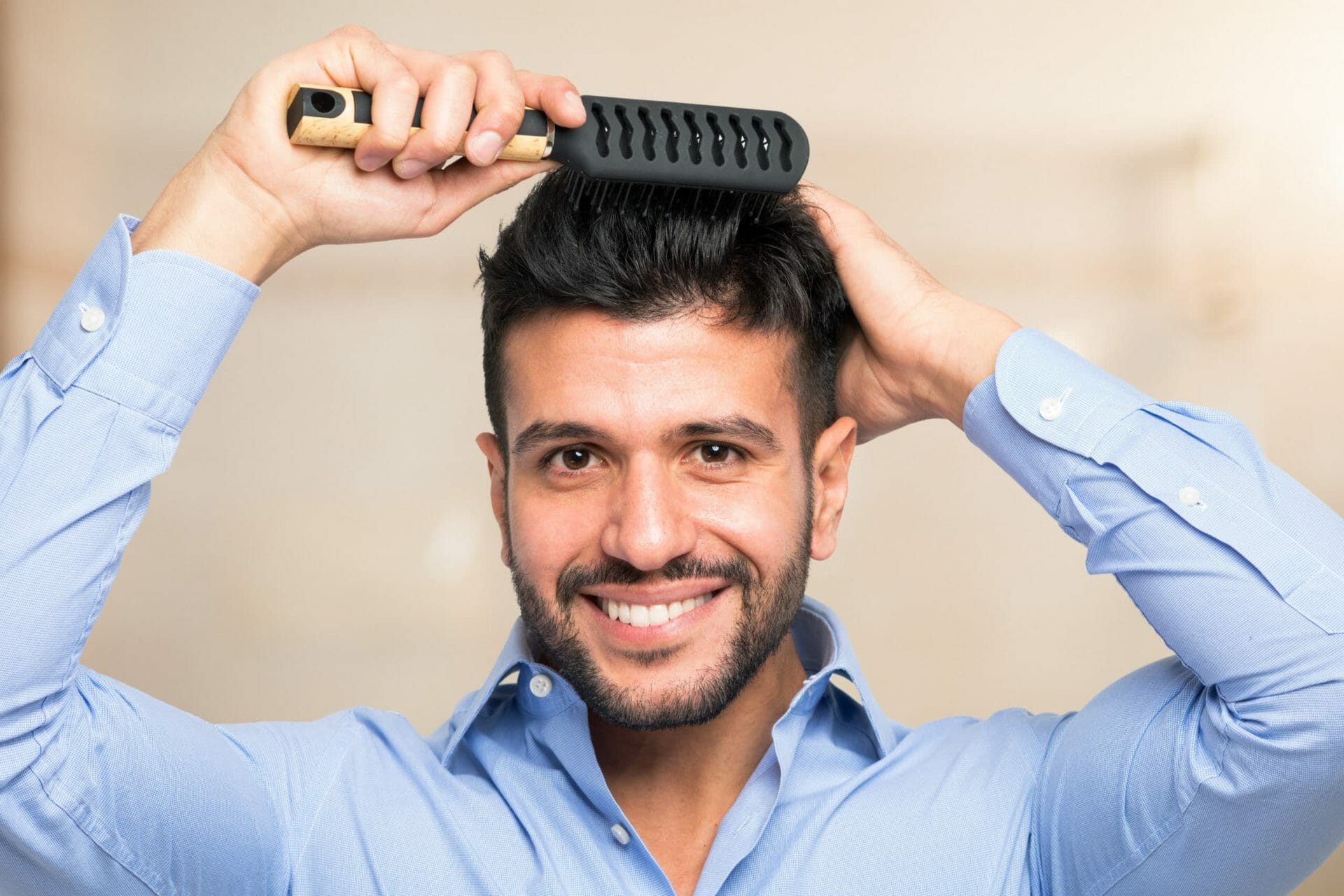Kyle Walker is known for his defensive skills at Tottenham Hotspur, Manchester City, and in the England squad. His skills have put him in the spotlight on the pitch.
Off the pitch, some fans speculated about changes in his hair, especially around the crown. In line with many modern athletes, including Ben Stokes, Xherdan Shaqiri, David Silva, and LeBron James, Kyle may have chosen a hair transplant to combat balding.

Walker hasn’t confirmed a transplant publicly, but the speculation stems from a noticeable transition. There is a noticeable thinning around his crown in one season as well some thinning in the front, which is followed by an apparently thicker coverage in more recent appearances. Without direct statements from Kyle Walker himself, we rely on photographic evidence that points toward an intervention.
Kyle Walker Before and After Observations
Walker’s crown appeared visibly thinning at one point, a usual sign of crown hair loss or general male pattern baldness. This can also be sped up with chronic stress, which an athlete like Kyle would be subjected to in high-pressure, competitive environments. On the other hand, sudden emotional or physical stressors can lead to another type of hair loss known as telogen effluvium, causing temporary hair shedding across the scalp.
Later images reveal a uniform coverage where short hair no longer exposes the scalp. This result could be from long-term hair loss treatments such as minoxidil, finasteride, dutasteride, or even natural oil remedies. However, such visible improvement is unlikely to occur over a short timeframe with these treatments alone. In cases where changes happen quickly, we could also think of camouflage fibres or similar volumising products as common and effective options. These can provide the appearance of fuller hair, especially for those not currently considering hair transplants or medication.

Since Kyle Walker hasn’t confirmed undergoing any procedure, we can only speculate. After our surgeons carefully reviewed the available photographic evidence, we conclude that his mid-scalp and crown thinning could have been managed effectively with a well-planned medical treatment plan. His Afro-textured hair (known for its naturally thick, curly structure) may also have helped to conceal thinning areas more easily, especially when grown out, as this hair type offers greater visual density and coverage.
However, a hair transplant could also achieve the desired density without relying solely on long-term medications. It’s still advisable to continue hair loss treatments after a transplant to prevent further loss of non-transplanted hairs.
Did Kyle Walker Really Have a Hair Transplant?
As we discussed above, the evidence points to a fair possibility. If he had a hair transplant, the fully shaved look he honed most of 2020 might have assisted the extraction and implanting stages of FUE (Follicular Unit Excision Hair Transplant), which leaves only small dot-like scars. FUT strip surgery might yield more grafts, but the linear scar can be an issue for an active footballer, as seen up close on camera. You may find our detailed blog comparing the differences between an FUE and FUT procedure, but for a brief overview:
Follicular Unit Excision (FUE):
During an FUE procedure, individual hair follicles, called “grafts”, are taken from the donor area of the scalp (often the hairs on the back and sides) and transplanted to the area of concern, such as the crown and mid-scalp. This method is popular due to its minimal scarring at the donor sites, easily concealed once the hair regrows, and its ability to produce natural-looking results. A short recovery period is another key advantage, making it a discreet and practical option for public figures like Kyle Walker, who likely needs to get back to the pitch without missing a beat.

Follicular Unit Strip Transplant (FUT):
An FUT, also known as the strip method, involves removing a small strip of scalp from the back of the head, where healthy hair follicles are typically located. These follicles (grafts) are then carefully extracted under a microscope and transplanted to the recipient site (area of hair loss). This method can yield a higher number of grafts in a single session, making it particularly suitable for individuals with extensive hair loss (i.e. Norwood 6 or 7), such as Elton John or Elon Musk. It does, however, leave a linear scar at the donor site, which will be visible with shorter hairstyles. For someone like Kyle Walker, who often keeps his hair cropped short, this method would likely have been noticeable if he opted for it.
What Type Of Hair Transplant Would Kyle Walker Benefit From?
In Walker’s case, he would benefit more from an FUE procedure, as he does not necessarily have to extract too many grafts at this stage of hair loss. Looking at the pictures from 2019, when he was in his late 20s, a common time for young men to experience hair loss, our expert surgeons suggest that his hair loss level would be Norwood 3 Vertex without much effect on the temples. The Norwood Hamilton Scale is a helpful tool used to grade the level of hair loss and plan subsequent treatment to address it.
Is the Exact Time of the Hair Transplant Known?
Images from around 2018–2020 show a more prominent thinning spots around the hairline and crown. Around early 2021, the areas looked denser. If he had a Follicular Unit Excision (FUE) hair transplant during the off-season or a lull in matches, that could explain the improved hair density. Additionally, there would have been enough downtime for initial healing and regrowth.
How Many Grafts Might Kyle Walker Have Needed?
Crown-focused repairs can require around 1,000 or more grafts based on the size of the balding area. If the midscalp region was touched up, too, the count might climb to 1,500 or higher. Each graft usually contains 1 to 4 hairs, so even a moderate procedure can provide substantial coverage.
Curious about how many grafts different areas usually need during an FUE hair transplant? We’ve broken it down for you here. You may also find our Graft Calculator helpful in assessing the number of grafts required to address the areas of hair loss.
Where Did Kyle Walker Get His Hair Transplant?
No clinic has been confirmed. However, a reputable, surgeon-led facility with advanced technology and dedicated aftercare would be essential for an athlete’s swift return to training. At The Treatment Rooms London, we pride ourselves on delivering a premium, personalised experience, led by surgeons at every stage of the journey. Our approach ensures natural results, minimal scarring, and continued support throughout the recovery journey to help achieve a successful restoration.
If you are looking for premium hair transplant clinics near Manchester or Brighton, visit our website to learn more.

Considerations for Walker’s Hair
Walker usually keeps his hair short, which can make any scarring more noticeable. For this reason, a near-scarless procedure such as FUE just makes sense. Future hair loss is another factor. If thinning extends beyond the transplanted region, a second session may be needed to maintain a natural look.
Another key consideration is his hair type. Afro-textured hair requires careful planning during both extraction, where precision and surgical skill are essential, and implantation, where each graft must be placed at the correct angle, direction, and with carefully planned spacing to match the natural density. This is especially important with Afro-textured hair, as placing grafts too closely in thinning areas could lead to overcrowding, causing healthy hairs, both existing and transplanted, to compete for nutrients, which may affect growth. It is best handled by experienced surgeons to achieve a natural-looking hairline and growth pattern, while also creating the appearance of greater density – something this hair type is uniquely suited for.
Kyle Walker Hair Transplant FAQs
Did Walker confirm having a hair transplant?
No, Kyle Walker has never publicly confirmed undergoing a hair transplant. However, there have been online claims suggesting he may have visited a Manchester hair transplant clinic for an FUE procedure.
Could it be stress-induced shedding that reversed?
Possibly, but a full regrowth, especially in the crown area, is uncommon without medical intervention or a hair transplant. In most cases, such visible improvement suggests a planned treatment rather than spontaneous recovery.
What would Kyle Walker’s hair transplant downtime be like?
FUE recovery is quick. Light exercise is fine after 7 days, intense workouts after 14 days, and contact sports like football after 1 month.
Ready to Learn More About FUE Hair Transplants?
FUE procedure fits the busy life of a Premier League athlete who wants minimal downtime. Similar to other sports professionals who confronted hair loss, Kyle Walker seems to have found a lasting way to keep his on-field and off-field image polished.
If you are interested in restoring your hair through an FUE or FUT Hair Transplant, don’t hesitate to contact our friendly and professional hair transplant clinic, so you too can experience excellent results like Wayne Rooney and Jurgen Klopp. Our team is here to provide you with tailored guidance from consultation all the way to aftercare.
Interested in More Celebrity Hair Transplant Journeys?
If you found exploring Kyle Walker’s hair transformation interesting, you might also enjoy reading about other well-known figures who’ve undergone hair restoration procedures:
- Cesc Fàbregas Hair Transplant: Before, After and His New Hairline
- Steven Whittaker’s Hair Transplant – Before And After
- Harry Kane Hair and Hairline
- Mo Salah’s Hair Transplant: Before, After, and His New Hairline
- Xherdan Shaqiri Hair Transplant: Before, After, and His New Hairline
- Has David Beckham Had A Hair Transplant?
- Andros Townsend Transplant: Before, After, and His New Hairline
- Dimitar Berbatov’s Hair Transplant: Before, After, and His New Hairline
- Antonio Conte’s Hair Transplant: Before, After, and His New Look
- John Cena Hair Transplant
Get in Touch
Don’t wait to reclaim your confidence, reserve your free consultation with our London-based hair transplant clinic today, or book at our FUE hair transplant clinic in Oxford. We’re happy to see clients from Brighton and Bristol as well.
Our award-winning team, including leading London hair transplant surgeons Dr Fernando and Dr Vara, is here to support you every step of the way.
Share:
Authored by
Reviewed by
Book a Consultation
Related Blogs
Which Medications Cause Hair Loss?
August 20, 2025
Medicines are essential in treating diseases, enhancing health, and even saving lives. While medicines can be very…
Does Vitamin C Deficiency Cause Hair Loss? Causes, Evidence & Nutrition Guide
August 20, 2025
Vitamin C, also known as ‘ascorbic acid’, is one of many critical water-soluble vitamins that play various…
Can Dry Shampoo Cause Hair Loss? Risks, Research & Safe Use
August 20, 2025
Dry shampoo is a time-saving staple for oily roots and no-wash days, but does this convenience come…
Does Saw Palmetto Work for Hair Loss? Evidence, Benefits and Side Effects
August 18, 2025
Male pattern or female pattern baldness, scientifically known as androgenetic alopecia (AGA), is a type of hair…
How Many Hair Grafts Do You Need For A FUE Hair Transplant?
August 8, 2025
A Follicular Unit Excision (FUE) or FUT hair transplant is one of the two main procedures available to address…
Do Hats Cause Hair Loss? Debunking Myths & Understanding the Facts
August 1, 2025
Hats have been a global trend to wear, whether for style, warmth, or sun protection. But have…
What Causes Hair Loss During Menopause?
July 30, 2025
For many women, hair is an expression of identity, personality and self-image. During menopause, the body undergoes…
Can Hair Brushing Stimulate Hair Growth?
July 30, 2025
Quick Summary: Hair Brushing and Hair Growth Brushing’s Real Benefits: While brushing doesn’t directly stimulate hair growth,…
Best Post-Hair Transplant Medication for Effective Recovery and Growth
July 15, 2025
Hair transplant surgery has become one of the most effective and reliable methods for physically reversing hair…











